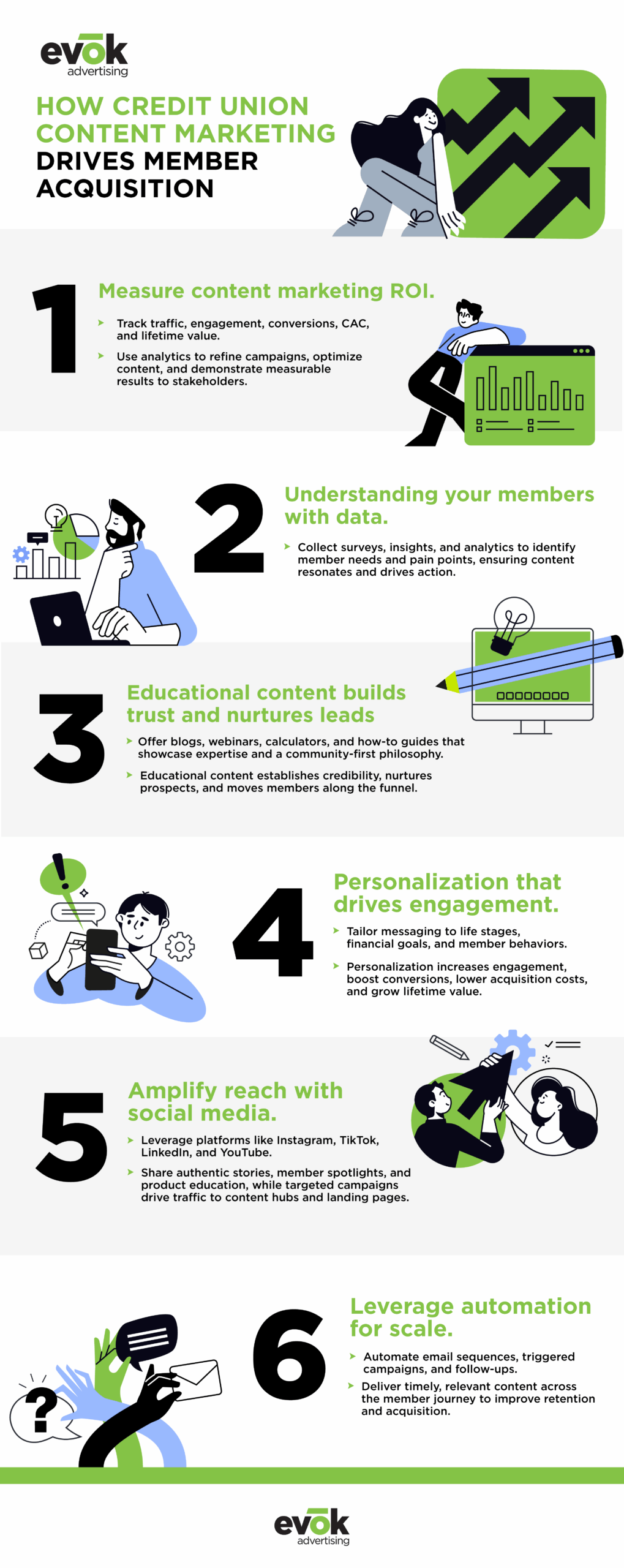
How Credit Union Content Marketing Drives Member Acquisition: A Data-Driven Strategy Guide for CMOs
Are your credit union’s marketing efforts truly resonating with today’s digitally-savvy consumers? The path to sustainable member acquisition lies not in traditional advertising but in a data-driven content strategy that builds trust and fosters genuine connection. This is where credit union content marketing emerges as a powerful, data-driven strategy that not only attracts new members but also builds lasting relationships. Content marketing is no longer just an option; it’s a necessity for credit unions looking to differentiate themselves in a crowded marketplace.
By partnering with a specialized credit union marketing agency, your organization can develop strategic, highly targeted content that educates, engages, and converts prospects into loyal members. Unlike broad financial advertising, credit union content marketing focuses on delivering value through tailored educational resources, personalized messaging, and storytelling that highlights your unique community connection and products. This approach drives measurable credit union member acquisition while improving marketing ROI through better lead nurturing and conversion optimization.
Moreover, credit unions leveraging advanced marketing analytics and digital marketing maturity models are optimizing every stage of the member journey, from awareness to onboarding. Integrating credit union social media marketing amplifies your reach and fosters authentic engagement, which is critical for building trust and loyalty in today’s digital-first environment. This blog will guide CMOs through a comprehensive, data-driven content marketing framework, one designed to position your credit union for sustainable growth in member acquisition and competitive advantage.

The Role of Content Marketing in Credit Union Member Acquisition
Credit unions face an ongoing challenge in the evolving financial services landscape to stand out against intense competition from banks and fintech firms. For Chief Marketing Officers (CMOs), the solution lies in adopting a credit union content marketing strategy that emphasizes delivering targeted, meaningful content tailored to prospective members’ unique needs, often informed by current banking industry marketing trends. Unlike traditional marketing tactics, content marketing fosters deeper connections by educating prospects, enhancing trust, and showcasing a credit union’s distinct value proposition, essential components for effective credit union member acquisition.
According to The Financial Brand, two credit union CMOs highlighted that individualized, personalized marketing has become pivotal in driving engagement and conversion rates. By crafting content that resonates with members on a personal level, leveraging behavioral and transactional data, credit unions can improve their credit union customer acquisition cost while boosting lead-nurturing effectiveness. This data-driven content marketing approach ensures that every interaction is relevant, creating a seamless path from awareness to membership.
Moreover, credit unions benefit by positioning their brand through storytelling that highlights their community-oriented mission, product offerings, and member-first philosophy. This approach strengthens credit union brand positioning, helping differentiate from larger banks whose messaging often lacks local relevance. Through consistent and strategic content creation, credit unions demonstrate their commitment to member experience, offering solutions that matter, from financial education and savings products to personalized loan options.
Implementing a robust credit union digital marketing strategy rooted in content marketing also improves marketing ROI by maximizing engagement across channels, including owned websites, email, and social media platforms. This integrated strategy is especially effective when aligned with performance metrics, allowing CMOs to track key indicators like credit union lead generation, conversion rates, and overall member growth.
How Personalization Boosts Credit Union Member Engagement and Conversions
Personalization has rapidly become a cornerstone of effective credit union content marketing, offering a pathway to more meaningful member engagement and higher conversion rates. In the current digital-first environment, members expect financial institutions to understand their unique needs, preferences, and life stages and tailor communications accordingly. CMOs who integrate personalized content into their credit union digital marketing strategy unlock significant advantages in reducing credit union customer acquisition costs and improving credit union conversion optimization.
Research shared by The Financial Brand reveals that leading credit union CMOs are leveraging individual member data, from transaction histories to digital behaviors, to create hyper-targeted marketing campaigns. This granular level of personalization goes beyond simple segmentation; it enables delivering timely, relevant content and product offers that feel genuinely useful to each potential member. For example, a first-time homebuyer might receive content on mortgage options and budgeting tips, while a retiree would see tailored advice on retirement savings plans. Such content nurtures leads more effectively by addressing members’ real concerns, which traditional blanket advertising cannot achieve.
Beyond boosting conversions, personalization enhances the overall members’ experience, fostering loyalty and advocacy. When members feel understood and valued, they are more likely to engage with additional products and services, such as auto loans or credit cards, deepening the relationship. This multi-product engagement further improves the lifetime value of members, a key metric for CMOs evaluating financial institution marketing ROI.
Implementing personalization requires a strong foundation in data collection, analytics, and marketing automation technologies, areas where a specialized credit union marketing agency can provide critical expertise. With the right tools, credit unions can continuously refine their messaging based on performance insights, ensuring ongoing optimization of their content marketing efforts.
Building Trust and Nurturing Leads with Educational Content in Credit Unions
Educational content plays a pivotal role in effective credit union content marketing by empowering potential members with valuable knowledge, fostering trust, and nurturing leads throughout their journey. Unlike traditional sales-driven messaging, educational content focuses on addressing the real financial questions and concerns members have, such as understanding loan options, managing credit, or planning for retirement. By delivering clear, relevant, and actionable information, credit unions position themselves as trusted financial partners rather than mere product vendors.
This trust-building aspect is essential in the financial services industry, where members seek institutions that genuinely prioritize their financial well-being. Providing educational resources, such as blog articles, webinars, calculators, and how-to guides, not only improves the overall members’ experience but also supports a more strategic financial institution lead nurturing process. As prospects consume helpful content tailored to their specific needs and life stages, they become more engaged and confident in the credit union’s expertise, increasing the likelihood of conversion. Content marketing allows credit unions to tell powerful stories of local impact – from funding small businesses in the neighborhood to sponsoring community events – truly embodying their ‘people helping people’ philosophy in a way larger banks often cannot.
Furthermore, well-crafted educational content strengthens credit union brand positioning by highlighting the credit union’s commitment to member success and financial literacy. This differentiated brand voice resonates in a competitive marketplace, where consumers increasingly seek personalized, trustworthy financial guidance. Ultimately, educational content nurtures leads more effectively, contributing directly to enhanced credit union member acquisition and sustainable growth.
Optimizing Credit Union Content Marketing with Data-Driven Insights

Data is the backbone of effective credit union content marketing strategies. For CMOs aiming to maximize credit union member acquisition and enhance financial institution marketing ROI, leveraging data-driven insights is no longer optional; it’s essential. Data empowers credit unions to understand member behaviors, preferences, and pain points, enabling them to craft content that resonates deeply and drives measurable results. Credit unions that excel in marketing are those that integrate advanced banking marketing analytics tools with their content marketing efforts. These tools collect and analyze data across channels, from website engagement to social media interactions, providing a 360-degree view of member journeys. This comprehensive understanding allows credit unions to optimize messaging, personalize experiences, and allocate resources toward the highest-performing campaigns, improving overall credit union lead generation.
Beyond tracking engagement metrics, data-driven content strategies involve establishing clear credit union marketing metrics and KPIs such as conversion rates, cost per acquisition, and lifetime member value. These benchmarks help CMOs justify marketing spend, optimize campaigns in real-time, and align marketing activities with broader organizational goals. Credit unions that adopt this approach consistently outperform competitors by reducing credit union customer acquisition costs while boosting acquisition volume. Another critical aspect is the use of predictive analytics to forecast member behaviors and tailor content proactively. For example, data models can identify members likely to refinance a mortgage or open a savings account, allowing marketers to deliver targeted offers that increase conversion optimization. Implementing a robust data-driven approach requires investments in technology and partnerships with experienced credit union marketing agencies or financial services marketing consultants who specialize in integrating analytics with content strategy. This ensures that the data informs not only campaign execution but also content creation, distribution timing, and channel selection. Harnessing data-driven insights transforms credit union content marketing from a cost center into a growth engine, driving smarter decisions, higher ROI, and stronger member acquisition outcomes.
Implementing Marketing Automation and Analytics Tools
For CMOs focused on scaling their credit union content marketing efforts, the adoption of marketing automation and analytics tools is a game-changer. These technologies enable credit unions to manage complex campaigns efficiently, deliver personalized content at scale, and gain precise insights into marketing performance. Together, automation and analytics form the foundation of a modern credit union digital marketing strategy designed to maximize financial institution marketing ROI and streamline credit union lead generation.
Marketing automation platforms allow credit unions to orchestrate multi-channel campaigns that respond to member behaviors in real time. For example, triggered email sequences can nurture new prospects who download an educational resource or abandon an online loan application. Automated workflows also help segment audiences based on demographics, product interest, or engagement levels, ensuring every message is relevant and timely, which enhances credit union conversion optimization and reduces credit union customer acquisition cost.
Analytics tools complement automation by providing in-depth reporting on campaign effectiveness across touchpoints. CMOs can monitor metrics like open rates, click-through rates, social media engagement, and website conversions to understand what content resonates and where there may be gaps in the funnel. This continuous feedback loop informs content refinement and strategic shifts, leading to sustained performance improvement.
According to Cuinsight, credit unions that effectively implement these tools can transition from reactive marketing to predictive marketing, anticipating member needs and proactively offering solutions. However, successful adoption requires careful planning and possibly partnering with a specialized credit union marketing agency that understands the nuances of financial regulations and member expectations. Marketing automation and analytics tools empower credit unions to execute sophisticated, data-driven campaigns with precision and scale, amplifying the impact of their content marketing and accelerating member acquisition.
Amplifying Reach Through Credit Union Social Media Marketing

For CMOs, social media platforms provide powerful channels to engage prospective members, showcase the credit union’s community values, and amplify educational and promotional content, all critical for boosting credit union member acquisition and strengthening credit union brand positioning. Unlike traditional advertising, social media allows for authentic, two-way conversations that build trust and foster member loyalty. Credit unions can leverage platforms such as Facebook, Instagram, LinkedIn, and Twitter to share stories that highlight member successes, financial tips, and community involvement. This narrative-driven approach aligns with the credit union’s mission and resonates more deeply with local audiences compared to generic bank messaging.
Furthermore, social media marketing supports lead generation by driving traffic to targeted landing pages, content hubs, and product offerings. With advanced targeting options, CMOs can focus advertising budgets on specific demographics, behaviors, and geographic areas, maximizing the efficiency of acquisition campaigns and improving credit union customer acquisition costs.
Insights from CCUL emphasize the importance of integrating social media analytics into overall banking marketing analytics frameworks. Measuring engagement rates, follower growth, and click-through conversions enables credit unions to continuously optimize content strategies and identify which campaigns most effectively contribute to member growth.
Additionally, social media serves as a critical channel for real-time member engagement and reputation management. Prompt responses to inquiries and active participation in conversations demonstrate the credit union’s commitment to member experience, further differentiating the brand.
Incorporating credit union social media marketing within a unified content marketing plan enhances reach, drives qualified leads, and nurtures relationships at scale, making it indispensable for credit unions targeting sustainable growth in today’s digital marketplace.
Best Practices for Effective Social Media Content in Credit Unions
To fully capitalize on credit union social media marketing, CMOs must develop content that not only attracts attention but also aligns with broader content marketing goals, driving credit union lead generation and supporting credit union conversion optimization. Best practices in social media content creation and management can transform these platforms from mere broadcasting tools into strategic assets that accelerate member acquisition.
- Authenticity is key. Credit unions should showcase real member stories, community initiatives, and behind-the-scenes glimpses that humanize the brand. This approach builds emotional connections and reinforces the credit union’s reputation as a member-first institution, strengthening the credit union’s brand positioning in a way that generic financial services marketing often cannot.
- Educational content tailored for social media, such as short videos, infographics, and live Q&A sessions, can simplify complex financial topics and provide immediate value. This type of content encourages shares and comments, broadening organic reach and improving banking content marketing ROI by increasing touchpoints without significant ad spend.
- CMOs should leverage social media advertising’s targeting capabilities to reach high-potential member segments. Layered targeting based on location, interests, and financial behaviors ensures that paid campaigns are cost-effective and yield higher-quality leads. Integrating these campaigns with marketing automation tools enables seamless follow-up and lead nurturing, boosting overall credit union marketing metrics.
- Consistent posting schedules and active engagement are essential. Timely responses to comments and messages demonstrate a commitment to an excellent member experience, further differentiating credit unions from less responsive competitors.
- Performance measurement through platform analytics allows CMOs to refine social strategies continuously. Monitoring metrics such as engagement rates, conversion paths, and member acquisition costs helps optimize content and campaign investments for maximum impact.
By applying these best practices, credit unions can leverage social media as a powerful extension of their content marketing efforts, driving both brand loyalty and sustainable member growth.
Measuring Content Marketing ROI for Credit Unions: Metrics That Matter

For Chief Marketing Officers, demonstrating clear returns on investment is essential when justifying marketing budgets and strategic initiatives. In credit union content marketing, measuring the right performance indicators ensures efforts translate into tangible business outcomes, particularly in credit union member acquisition and revenue growth. Understanding and tracking key credit union marketing metrics allows CMOs to optimize campaigns, refine messaging, and align marketing activities with organizational goals.
The foundation of measurement begins with defining success criteria relevant to credit unions’ unique contexts. Core metrics include website traffic driven by content, engagement rates on social media, email open and click-through rates, and most importantly, lead conversion rates—from inquiry to member enrollment. These metrics provide insights into how effectively content resonates with the target audience and moves prospects through the sales funnel.
Furthermore, tracking credit union customer acquisition cost (CAC) is critical for assessing financial efficiency. Lowering CAC while increasing member acquisitions indicates a successful content marketing program. Advanced credit unions integrate banking marketing analytics platforms to correlate marketing spend with new member growth and lifetime value, providing a holistic view of marketing ROI. CMOs should also measure the impact of content on product cross-sell and member retention, as strong content strategies often drive multi-product engagement and deeper loyalty, both key to improving overall financial institution marketing ROI.
Insights from industry leaders stress the importance of continuous data analysis to adapt strategies. Monitoring performance regularly allows credit unions to identify high-performing content themes, channels, and formats to double down on success and pivot from underperforming tactics. Incorporating attribution modeling helps CMOs understand which content and touchpoints most influence member decisions, enabling more informed budget allocation and campaign planning. Ultimately, this rigorous approach to measurement elevates content marketing from a cost center to a growth driver, showcasing its vital role in credit union marketing strategies.
Tools and Techniques for Tracking Credit Union Marketing Performance
To accurately measure the impact of credit union content marketing, CMOs need robust tools and techniques that provide actionable insights across all marketing channels. Selecting and implementing the right analytics platforms is essential for capturing detailed data on member behaviors, campaign effectiveness, and ROI, enabling continuous optimization of the credit union’s digital marketing strategy.
Web analytics tools like Google Analytics offer foundational metrics, tracking visitor sources, page views, bounce rates, and conversions on credit union websites. These insights reveal which content pieces are driving the most traffic and engagement, helping prioritize content development aligned with financial services content strategy goals.
For deeper attribution and multi-channel tracking, marketing automation platforms such as HubSpot or Marketo provide integrated dashboards that monitor email campaigns, social media performance, and lead-nurturing workflows. This consolidated view assists in evaluating the full member acquisition journey, from first touch through conversion, optimizing the credit union’s lead generation funnel. Social media analytics tools native to platforms like Facebook Insights and LinkedIn Analytics offer granular data on audience demographics, engagement patterns, and ad campaign results, supporting refined credit union social media marketing strategies.
Additionally, credit unions are increasingly adopting customer data platforms (CDPs) and CRM systems to unify data from various sources, enabling personalized content delivery and more precise measurement of credit union customer acquisition cost and lifetime value. Regular use of A/B testing and conversion rate optimization (CRO) techniques further enhances marketing performance by identifying the most effective messaging, design, and calls to action.
Partnering with a specialized credit union marketing agency, financial services marketing consultant, or credit union advertising agency can provide access to advanced tools and expertise, ensuring that credit unions implement measurement systems compliant with industry regulations and optimized for growth. In essence, leveraging a comprehensive suite of analytics and automation tools empowers CMOs to transform raw data into strategic insights, driving smarter content marketing decisions and superior member acquisition results.
Transform Your Credit Union’s Growth with Strategic Content Marketing

For CMOs leading credit union marketing initiatives, embracing a comprehensive, data-driven credit union content marketing strategy is key to accelerating member acquisition and gaining a competitive edge. By blending personalized content, educational resources, and targeted social media campaigns, underpinned by robust data analytics and marketing automation, credit unions can deliver meaningful member experiences that drive trust, engagement, and conversions.
The integration of advanced banking marketing analytics enables precise measurement of ROI, guiding continual optimization and ensuring marketing budgets yield the greatest impact. Meanwhile, partnering with a specialized credit union marketing agency or financial services marketing consultant provides the expertise and tools needed to navigate the complexities of this evolving landscape.
Ultimately, credit union content marketing is not just a tactic but a strategic growth engine that nurtures prospects, reduces credit union customer acquisition cost, and strengthens brand positioning in an increasingly digital marketplace.
Ready to elevate your credit union’s marketing strategy? Partnering with a specialized agency, such as evok Advertising, backed by over a decade of experience serving financial institutions, empowers your organization to create a customized content marketing plan that drives measurable results and fosters long-term member loyalty. Contact us today to get started!